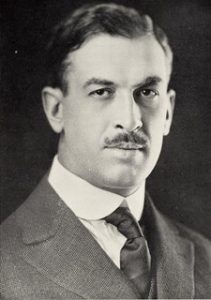
Photo info ...
Credit: ddeedavis via Find A GraveView Source
(May 2, 1877-July 9, 1947). Born in Indianapolis and educated in its public schools, Robert H. Tyndall enlisted in the 27th Indiana Volunteers in 1897. The 27th fought in Puerto Rico during the Spanish-American War. Following the conflict, Tyndall married Dean Spellman, a daughter of Samuel and Emma Spellman of Indianapolis. The couple had three children.

By the time the U.S. declared war on Germany in 1917, Tyndall had reached the rank of major and was in command of a battalion of the Indiana Field Artillery stationed on the Mexican border. When the U.S. mobilized for the conflict, the Indiana Field Artillery became the Field Artillery Regiment, assigned to the U.S. Army 42nd Infantry “Rainbow Division.” Tyndall was promoted to colonel and commanded the entire regiment, which participated in several battles in 1918.
For his World War I service, he was awarded the Distinguished Service Medal, the Croix de Guerre (French), and the Commander of the Legion of Honor (French). Tyndall remained in Germany, during its occupation. After recovering from a severe case of the Spanish flu, he returned to the U.S. and was honorably discharged from active duty in May 1919.
As a civilian following World War I, he was a vice president of and, in 1925, became treasurer of the Carl G. Fisher Automobile Company, which perhaps was the first automobile dealership in the nation. At the same time, Tyndall continued to serve as a colonel in the Field Artillery Officer’s Reserve Corps and as national treasurer of the . In 1924, he was promoted to major general.
The 38th Division of the Indiana National Guard was organized in Indianapolis in 1923. Tyndall and Col. Robert H. Moorhead, a member of the Indiana State Armory Board who had been one of the individuals involved in getting Indianapolis chosen as American Legion headquarters, were instrumental in getting a new permanent armory approved to accommodate the 38th and its supporting divisions. Considering the involvement of the two men in both ventures it was no accident that the new armory was located across from the and American Legion headquarters at 711 North Pennsylvania Street. It was dedicated in 1926.
From 1932 to 1942, Tyndall was associated with the Russell B. Moore Company, Inc., a consulting engineer firm. When the U.S. declared war in 1941, Tyndall went to Camp Shelby, located in Mississippi, as commander of the 38th Division and mobilized 50,000 troops. He, however, was forced to retire from military service when he turned 64. Tyndall also served as a director of the Marion County Civilian Defense Council and as director of the Marion County Red Cross.

After he left the Army, Tyndall turned to politics. When elected mayor in 1943, he was the city’s first Republican to serve in the position since 1926. During his administration, Tyndall secured passage of legislation to operate on a nonpartisan basis, planned for a Veterans Administration hospital, addressed the issue of smoke abatement, and amended the 1925 thoroughfare plan to include widening and resurfacing city streets.
His administration created the , in 1943, to develop a 17-year plan for city improvement through a public works program that would employ returning World War II veterans. The committee also established the Indianapolis Redevelopment Commission (duties later taken on by the Department of Metropolitan Development) which, under a 1945 state law, cleared and rezoned areas in the city deemed “blighted.” In his last official act as mayor, Tyndall approved $1.8 million (about $28.9 million in 2020) for sewer system improvements.
The armory on Pennsylvania Street was named in his honor in 1967.

Help improve this entry
Contribute information, offer corrections, suggest images.
You can also recommend new entries related to this topic.